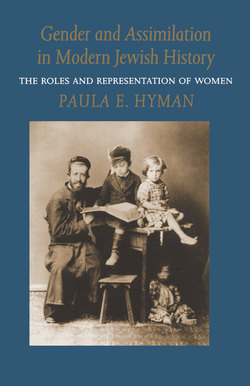Читать книгу Gender and Assimilation in Modern Jewish History - Paula E. Hyman - Страница 9
На сайте Литреса книга снята с продажи.
ОглавлениеPreface
I have been interested in the history of Jewish women since my days as a graduate student some twenty years ago. Although my own professional training was conspicuously silent on the subject of women, and gender was a concept of interest only to anthropologists studying primitive tribes, my involvement with feminism at the university and in the Jewish community sparked my curiosity about women in the past and the role of gender in human experience. Beginning with a collaborative effort on the history of Jewish women in America, whenever time permitted I returned to the subject of women in modern Jewish history. As I read more broadly in the growing and ever more sophisticated literature in general women’s history and pursued my own research, I became convinced that there was much to say about the relation between gender and the encounter of Jews with the various conditions of modernity. The invitation to offer the Stroum Lectures at the University of Washington in 1992 permitted me to reflect upon the roles and representation of Jewish women as Jews struggled to define a place for themselves in Europe and America. The questions that I raise in this slim volume, though limited to Ashkenazi Jews, will, I hope, stimulate others to investigate the experience of women and gender representations in Sephardi communities and in other parts of the Jewish world, including the prestate yishuv and Israeli society.
The publication of this book provides me with the happy opportunity of thanking a series of individuals who contributed to its appearance. Samuel and Althea Stroum’s generosity and commitment to Jewish learning provided the framework for the lectures which form the basis of this book. I am most grateful to Professor Hillel Kieval and his colleagues in the University of Washington’s Jewish Studies Program for inviting me to Seattle. Their gracious hospitality, ably coordinated by the program’s assistant, Dorothy Becker, combined with unusually warm and sunny weather to offer a serene setting for reflecting on my subject in addition to delivering the lectures themselves. The questions from faculty and other members of the audience initiated a process of extending and clarifying my ideas.
At Yale my work in progress on gender and assimilation was assisted by colleagues in a number of settings. I am particularly grateful to the Whitney Humanities Center Fellows and to the Women’s Studies Faculty Council, who listened to early versions of my arguments and offered suggestions for further research and refinement of my major points. Two groups of students in my undergraduate course on women and Judaism stimulated my thinking, as did my then graduate student Beth Wenger. It is a pleasure for a scholar to be part of an institution that encourages the building of bridges across fields and disciplines and thereby promotes intellectual creativity.
I was fortunate to work in libraries and archives with rich resources for the study of modern Jewish history. To the staffs of the Jewish National and University Library in Jerusalem, the YIVO Institute, the library of the Jewish Theological Seminary, and the Jewish Division of the New York Public Library, as well as the libraries of Yale, I express my gratitude.
Several colleagues read one or more drafts of this book and offered encouragement, editorial advice, and constructive criticism. At each stage—conducting my research, preparing the lectures for presentation, and transforming the lectures into a book—I could count on Richard Cohen, Debórah Dwork, Marion Kaplan, and Deborah Dash Moore. For fifteen years Marion Kaplan has stimulated my thinking about Jewish women, and her research has been invaluable for my own. As usual, Deborah Moore has spurred me to my best work through her multiple roles as friend, editor, and partner in debate. The book is the better for their concern; I alone am responsible for its deficiencies. Many thanks to my editors Naomi Pascal and Pamela Bruton for their support and commitment to high editorial standards.
My family has shared in this endeavor, listening with more patience than could be expected to tales culled from memoirs of forgotten women. My husband, Stanley Rosenbaum, read each draft with an eye to crafting a narrative for the intelligent but nonspecialist reader. My daughters, Judith and Adina, have inspired me with their continued enthusiasm for this project, even as over the course of two years they heard more about one female activist, Puah Rakowski, than they ever dreamed of. Their lives are the continuation of the tale I have tried to tell, and it is to them that I dedicate this book with great love.
